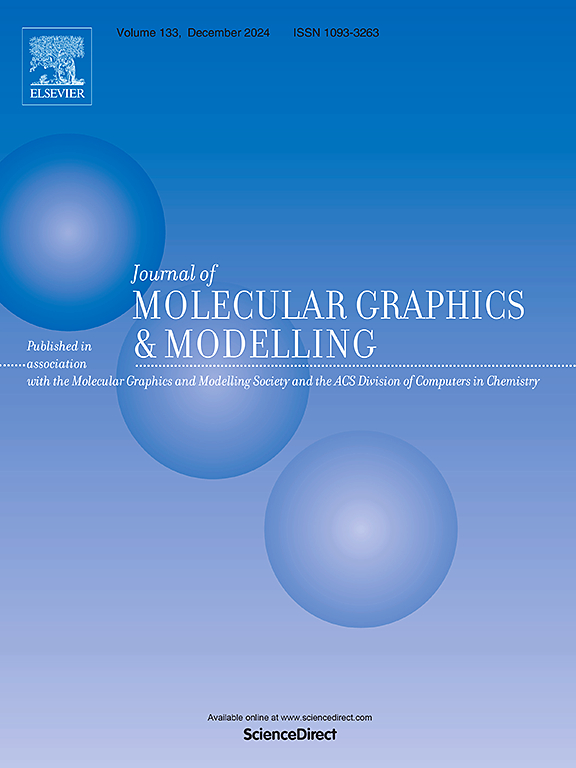通过DFT计算揭示了联苯网络对氯代脂肪烃污染物的感知特性
IF 3
4区 生物学
Q2 BIOCHEMICAL RESEARCH METHODS
引用次数: 0
摘要
联苯是最近合成的一种石墨烯同素异形体,在污染物吸附和传感应用方面具有潜力。在本研究中,我们利用密度泛函理论计算,研究了联苯和三种氯化脂肪烃(二氯乙烯、三氯甲烷和四氯乙烯)之间的相互作用。几何分析表明,所有配合物的相互作用距离均在3.3 Å以上,表明物理吸附受范德华力支配。与四氯乙烯的配合物由于π -π堆积表现出最强的相互作用(吸附能为- 0.48 eV),而与三氯甲烷和二氯乙烯的配合物表现出较弱的吸附能(分别为- 0.30 eV和- 0.35 eV)。溶剂效应略微降低吸附稳定性,可达6%。电子分析表明,联苯在络合后保持了其固有性质,HOMO-LUMO间隙(1.00 eV)和化学势(- 3.92 eV)的变化很小。然而,偶极矩显著增加(三氯甲烷配合物的偶极矩高达1.40 D),增强了溶解度。与三氯甲烷(1.33 × 10−7 s)和二氯乙烯(8.41 × 10−7 s)配合物的快速恢复时间表明了出色的传感能力,而四氯乙烯系统的较长解吸时间(1.42 × 10−4 s)表明了污染物吸附的潜力。这些发现突出了联苯作为一种有前景的环境应用材料,包括感应和去除氯化污染物。本文章由计算机程序翻译,如有差异,请以英文原文为准。

Unveiling the chlorinated aliphatic hydrocarbon contaminants sensing properties of the biphenylene network through DFT calculations
Biphenylene, a recently synthesized graphene allotrope, has demonstrated potential for pollutant adsorption and sensing applications. In this study, we investigate the interactions between biphenylene and three chlorinated aliphatic hydrocarbons: dichloroethylene, trichloromethane, and tetrachloroethylene, utilizing density functional theory calculations. Geometrical analysis shows that all complexes exhibit interaction distances above 3.3 Å, indicating physisorption governed by van der Waals forces. The complex with tetrachloroethylene exhibits the strongest interaction (adsorption energy of −0.48 eV) due to π–π stacking, while the systems with trichloromethane and dichloroethylene exhibit weaker adsorption (−0.30 eV and −0.35 eV, respectively). Solvent effects slightly diminish adsorption stability by up to ∼6 %. Electronic analysis reveals that biphenylene retains its intrinsic properties upon complexation, with minimal changes in the HOMO-LUMO gap (1.00 eV) and chemical potential (−3.92 eV). However, the dipole moment increases significantly (up to 1.40 D for the trichloromethane complex), enhancing solubility. Rapid recovery times for the complexes with trichloromethane (1.33 × 10−7 s) and dichloroethylene (8.41 × 10−7 s) suggest excellent sensing capabilities, while the tetrachloroethylene system's longer desorption time (1.42 × 10−4 s) indicates potential for pollutant adsorption. These findings highlight biphenylene as a promising material for environmental applications, including the sensing and removal of chlorinated pollutants.
求助全文
通过发布文献求助,成功后即可免费获取论文全文。
去求助
来源期刊

Journal of molecular graphics & modelling
生物-计算机:跨学科应用
CiteScore
5.50
自引率
6.90%
发文量
216
审稿时长
35 days
期刊介绍:
The Journal of Molecular Graphics and Modelling is devoted to the publication of papers on the uses of computers in theoretical investigations of molecular structure, function, interaction, and design. The scope of the journal includes all aspects of molecular modeling and computational chemistry, including, for instance, the study of molecular shape and properties, molecular simulations, protein and polymer engineering, drug design, materials design, structure-activity and structure-property relationships, database mining, and compound library design.
As a primary research journal, JMGM seeks to bring new knowledge to the attention of our readers. As such, submissions to the journal need to not only report results, but must draw conclusions and explore implications of the work presented. Authors are strongly encouraged to bear this in mind when preparing manuscripts. Routine applications of standard modelling approaches, providing only very limited new scientific insight, will not meet our criteria for publication. Reproducibility of reported calculations is an important issue. Wherever possible, we urge authors to enhance their papers with Supplementary Data, for example, in QSAR studies machine-readable versions of molecular datasets or in the development of new force-field parameters versions of the topology and force field parameter files. Routine applications of existing methods that do not lead to genuinely new insight will not be considered.
 求助内容:
求助内容: 应助结果提醒方式:
应助结果提醒方式:


